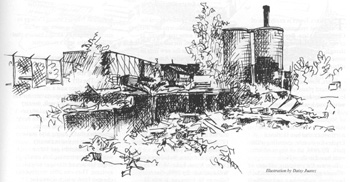 |
Home | Search | Browse | About IPO | Staff | Links |
 |
Home | Search | Browse | About IPO | Staff | Links |
In a state where the Environmental Protection Agency moved its own headquarters to a former brownfield site — the location of the long-gone Illinois Watch and Sangamo Electric companies near downtown Springfield — perhaps it's no surprise that measurable progress is being made to redevelop these contaminated properties.
In fact, Gov. George Ryan pledged to put $13.2 million in the state's fiscal year 2001 budget, beginning July 1, for mitigation and cleanup of these properties, which vary in size, location, age and past use. Such properties can encompass a several-hundred- acre shuttered steel mill or an abandoned corner gas station.
But cities throughout Illinois have already made headway in turning abandoned buildings and land into potentially profitable enterprises, says Steve Colantino, who heads the Illinois Brownfields Initiative. The initiative represents the state's collective effort to clean and redevelop brownfields, which the environmental agency defines as abandoned, unused or underused industrial and commercial properties with actual or perceived contamination.
And while states and cities all over the country have turned their attention to recycling such areas, Chicago stands out for its success in turning veritable land lemons into lemonade, Colantino says. Indeed, in 1998, the city received a Brownfields Showcase award from the U.S. Environmental Protection Agency for making strides toward redeveloping these abandoned sites.
The key to tackling brownfield redevelopment, says Jim Bower, who has worked with these properties on many levels, is to see them mainly as real estate opportunities rather than environmental liabilities.
"The environmental equation actually is the easiest to solve, but it's the piece of the problem that has traditionally scared the development community away from brownfields,'' says Bower, who worked as an expert in this area for both the U.S. EPA and the city of Chicago until two years ago. That's when he joined the real estate firm of Colliers, Bennett and Kahnweiler, which is considered one of the city's leading brownfield redevelopers.
"The much larger factor is market demand and supply,'' he says. "Why have we been successful at doing what we are doing? Because we've found that with inner-city industrial development in Chicago: If you build it, people will come. It has nothing to do with whether the site is environmentally impaired. First and foremost, it's a real estate deal.''
Bower's firm is developing several of the 300 brownfield sites in Chicago that were initially part of the state's voluntary cleanup program. The Illinois environmental agency launched that program nearly five years ago as a way to guide developers through the process of getting land clear enough of pollutants that it can be used to some extent. Under the program, the state even lends staff assistance to cities to help guide local officials, developers and others through what might at first look like an intimidating cleanup process, Colantino says.
A 1995 state law changing liability standards for redeveloping Illinois' contaminated sites helped spark developers' interest, too, because it limited their liability for pollution they had not caused.
Beyond that, Chicago merits credit for trying to be innovative in securing funds and other assistance from a wide variety of sources. One example Bower cites is the city's assertive use of targeted property tax abatements, which he says have allowed his firm to finance deals that otherwise would be cost-prohibitive.
One of the more high-profile redevelopment projects Bower has been involved with is the redevelopment of Goose Island on the Chicago River, where Colliers, Bennett and Kahnweiler is tearing
Illinois Issues April 2000 | 30

Contributing to Chicago's ability to fuel interest in redeveloping brownfields, says Brooke Furio of the U.S. EPA's District 5 office in Chicago, is the city's efforts to leverage money from federal agencies beyond the EPA. By tapping into several problems brownfield redevelopment can help solve, including housing, unemployment and transportation, the city can get aid from the federal departments of Housing and Urban Development and Energy, as well as the Army Corps of Engineers.
“The EPA might get involved and provide some help, but maybe [the Department of] Transportation can come in and put in a highway ramp to improve a property's marketability,’’ Furio says.
Another chief ingredient in Chicago's initiative was a forum created a few years ago that brought together real estate developers, industrialists, bankers, lawyers and representatives of local, state, and federal government agencies as well as environmental advocates and community groups, says Jessica Rio, a city Department of Environment spokeswoman who has worked on the city's brownfields programs.
“It was a real asset to have those people come together,’’ she says. “They were able to learn where each other's concerns were, and also work together to follow moves in the legislature that might have hurt the brownfield development effort.’’
There's no question that far more work remains than what has already been accomplished. But successes under cities’ belts are the best advertisements to other developers. “These days, [brownfields are] becoming more of an issue like a bad roof would be,” Bower says. “It's part of the cost of a deal, but it's not as likely to kill the deal.
Jennifer Halperin, a former Illinois Issues Statehouse bureau chief, is an editorial writer for the Columbus Dispatch.
Illinois Issues April 2000 | 31
|
Sam S. Manivong, Illinois Periodicals Online Coordinator Illinois Periodicals Online (IPO) is a digital imaging project at the Northern Illinois University Libraries funded by the Illinois State Library |